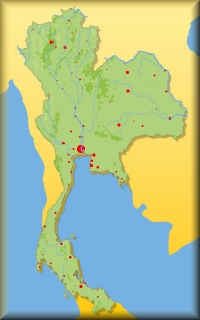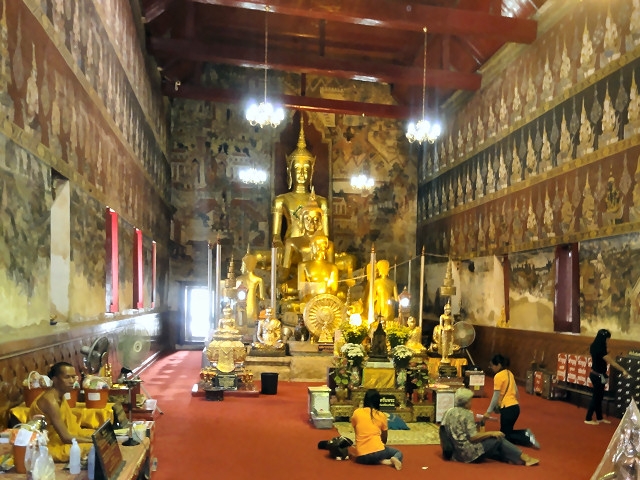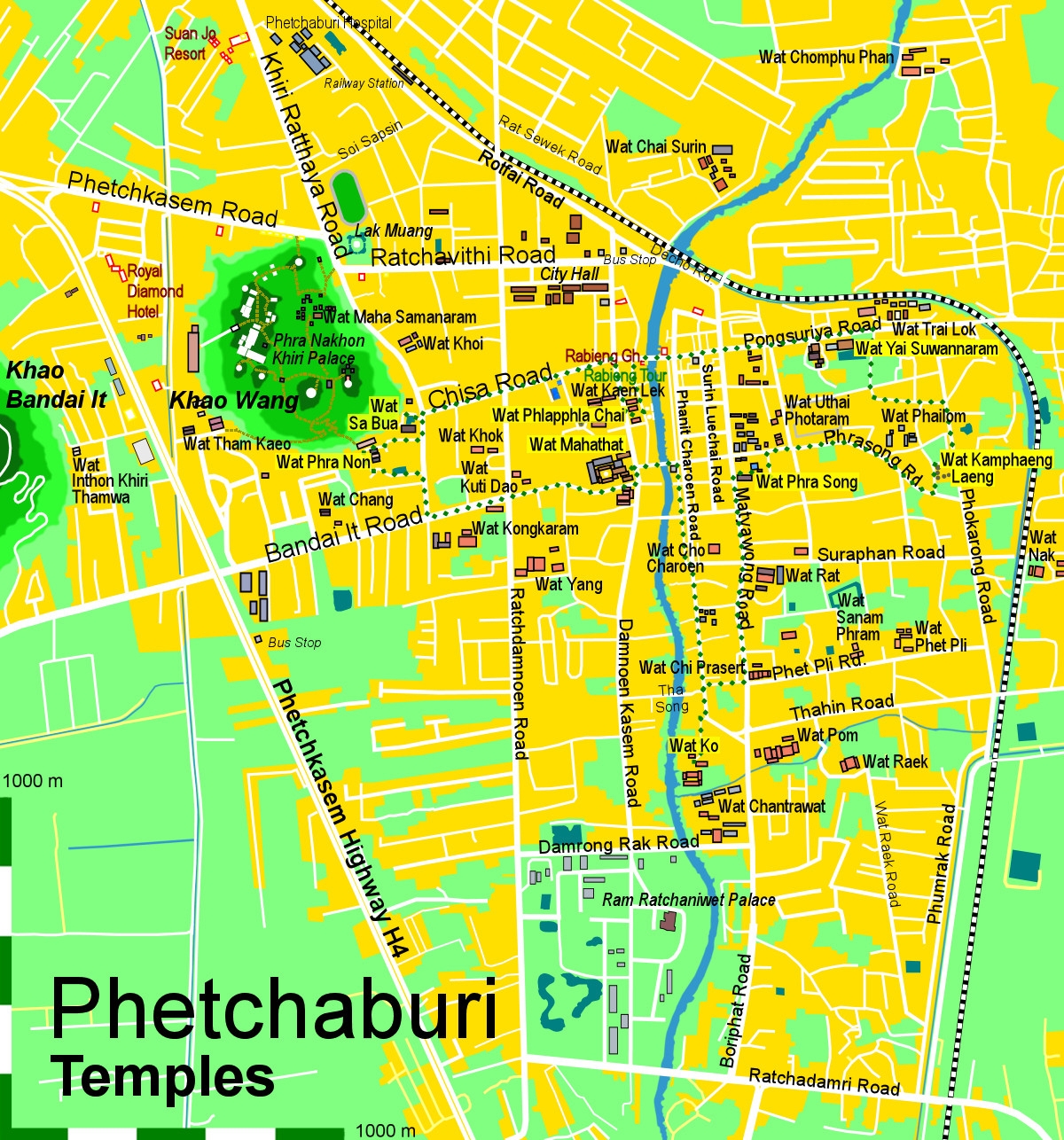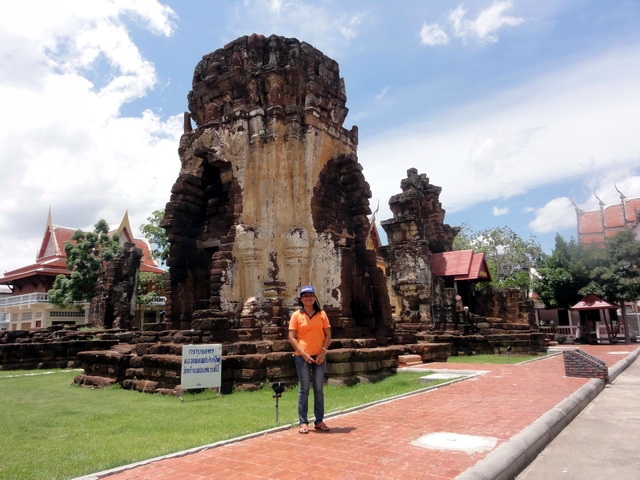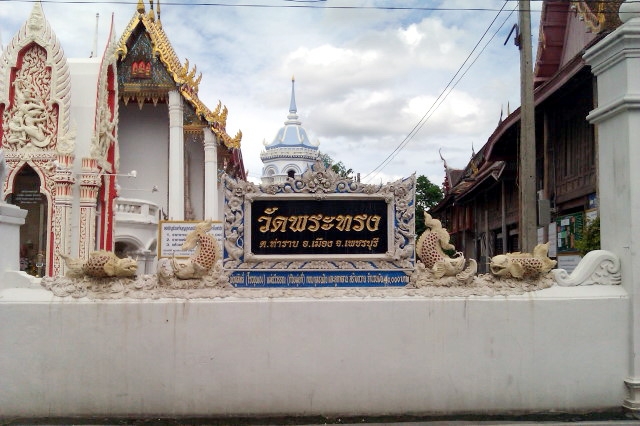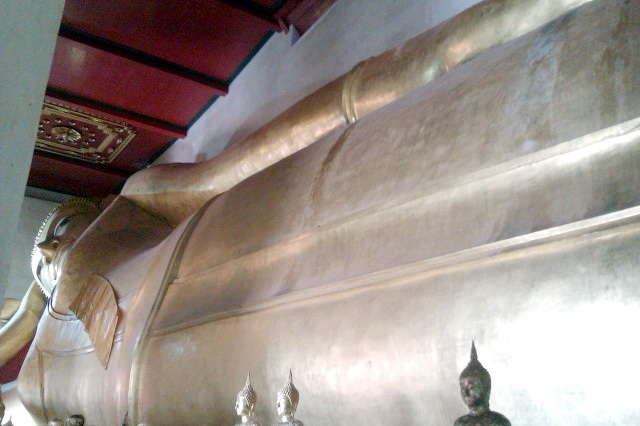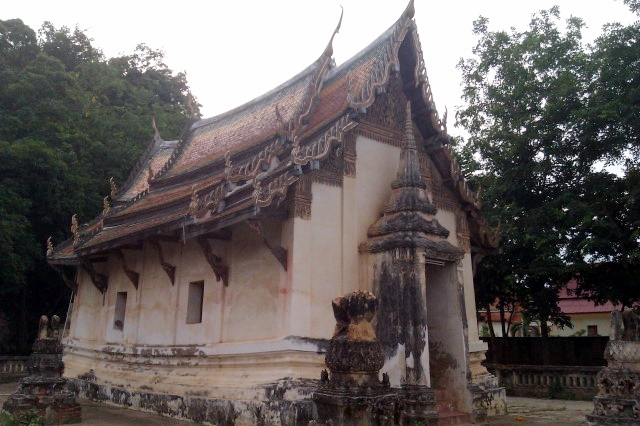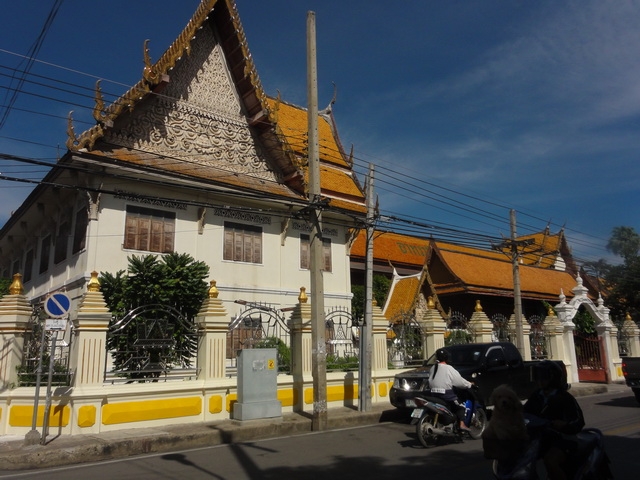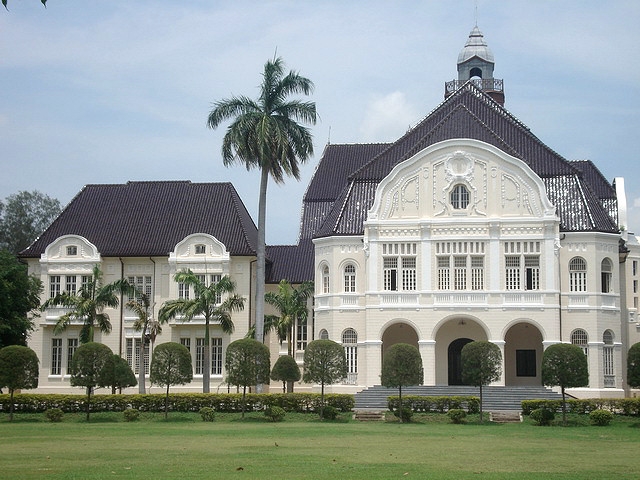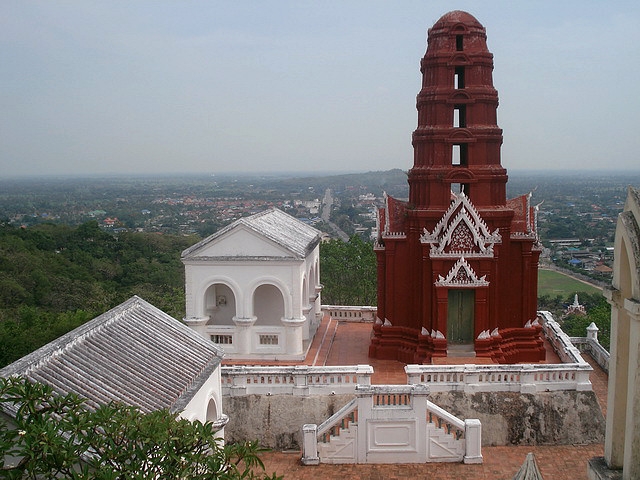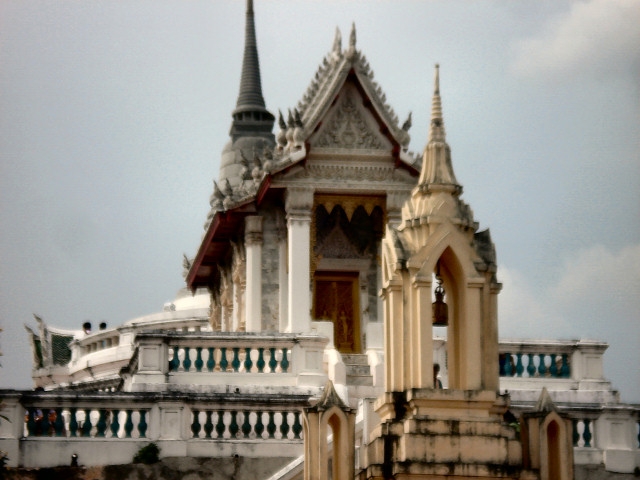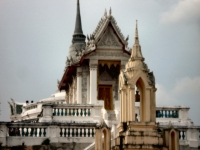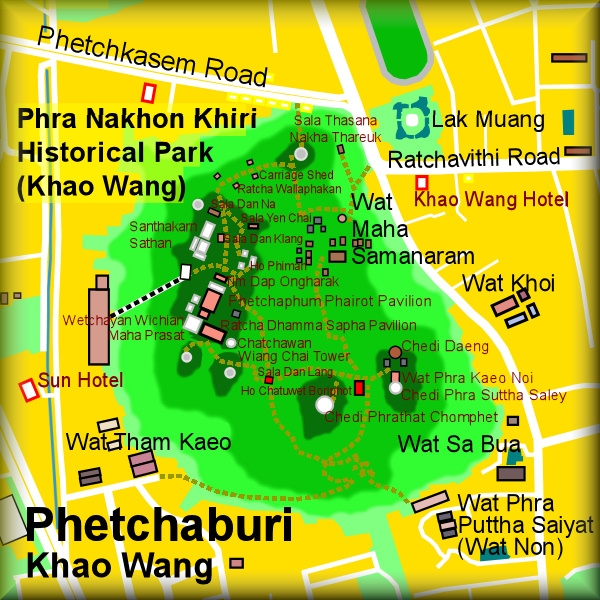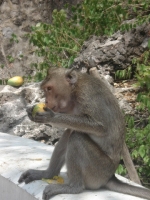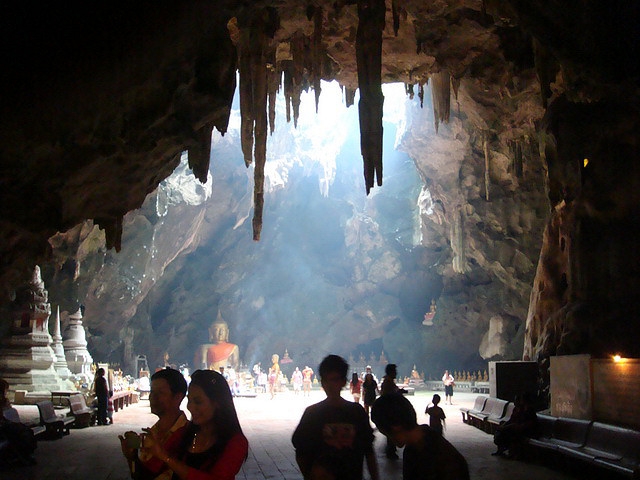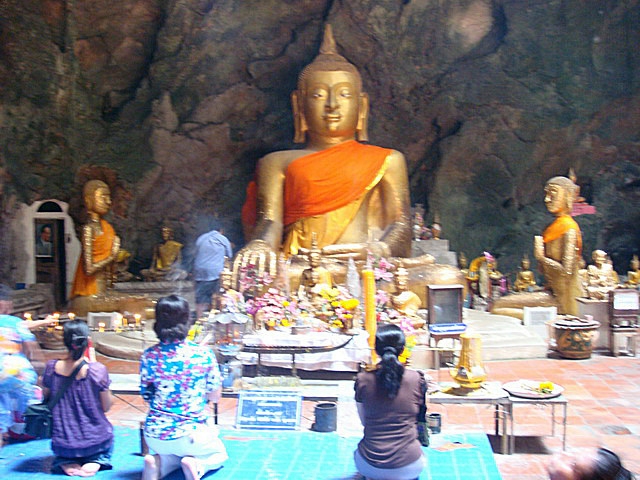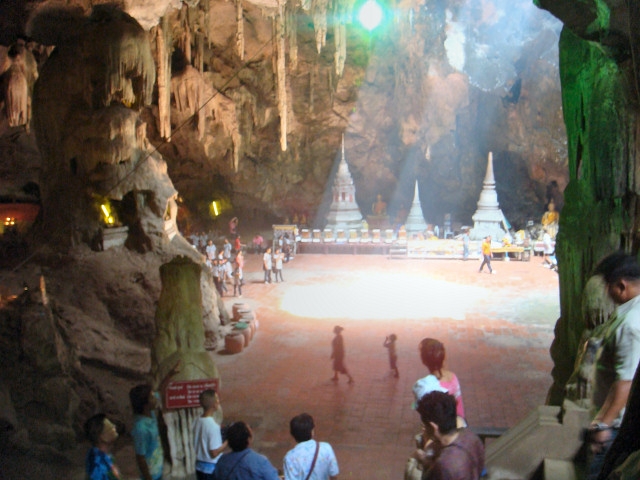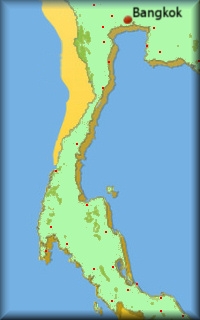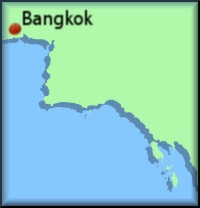 |
Famous Attractions in Phetchaburi
Destination: Phetchaburi
Temple >>
Wat Mahathat (Wat Mahathat) (Phetchaburi) 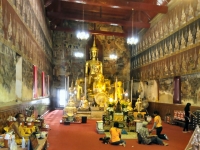 Wat Mahathat Worawihan (its full name) in the city center is more than 1,000 years old. In recent years Wat Mahathat was restored and enlarged. From the outside the prang with its five tall, corn-shaped stupas as well as the chedi with the four-headed Brahma gives an impressive sight. Wat Mahathat Worawihan (its full name) in the city center is more than 1,000 years old. In recent years Wat Mahathat was restored and enlarged. From the outside the prang with its five tall, corn-shaped stupas as well as the chedi with the four-headed Brahma gives an impressive sight.The main hall is painted with scenes from the Ramayana and is used by many people for praying and offering sacrifice. Almost every morning various groups perform temple dances in front of this building. A large monastery area and a school are adjoined to the temple.
Temple >>
Wat Yai Suwannaram (Wat Yai Suwannaram) (Phetchaburi) 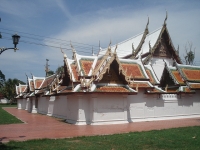 Wat Yai Suwannaram dates from the Ayutthaya period. It was renovated during the reign of King Sua or King Si Sanphet VII of Ayutthaya. It houses many beautiful wooden buildings. The central windowless bot's interior walls are decorated with over 300-year-old wall paintings showing among others, mythical creatures. You can ask to open the door. The Wiharn features particularly beautiful wooden entrance gates which are decorated with carved and gilded flower motifs. Wat Yai Suwannaram dates from the Ayutthaya period. It was renovated during the reign of King Sua or King Si Sanphet VII of Ayutthaya. It houses many beautiful wooden buildings. The central windowless bot's interior walls are decorated with over 300-year-old wall paintings showing among others, mythical creatures. You can ask to open the door. The Wiharn features particularly beautiful wooden entrance gates which are decorated with carved and gilded flower motifs.The legendary axe mark and the magnificent front door panels are the most beautiful and perfectly carved gilt work in this temple. It is believed that Burmese soldiers left an axe mark on the door panel. The Holy Sermon Hall was built in a classical style. There are some valuable religious artifacts and murals remaining on the wooden walls. The extraordinary three-pole library is built on three poles in a pond. It is used for keeping religious scripts out of the reach of insects. Wat Yai is located on Phong Suriya Road, about 1 km. from the City Hall.
Temple >>
Wat Kamphaeng Laeng (Wat Kamphaeng Laeng) (Phetchaburi) 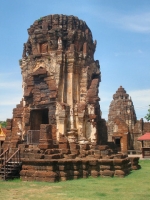 This temple was formerly a Khmer sanctuary in Hinduism, but adapted into a Buddhist temple in the Mahayana Sect and Theravada Sect, respectively. Originally it comprised 5 laterite prang towers; only 4 of them remain at present. It is assumed that each tower was dedicated to and housed an image of a Hindu god; such as Shiva, Visnu, Brahma and Uma. This temple was formerly a Khmer sanctuary in Hinduism, but adapted into a Buddhist temple in the Mahayana Sect and Theravada Sect, respectively. Originally it comprised 5 laterite prang towers; only 4 of them remain at present. It is assumed that each tower was dedicated to and housed an image of a Hindu god; such as Shiva, Visnu, Brahma and Uma. This is based on the fact that an image of the Goddess Uma or Parvati was discovered in a tumbled tower in 1956. When it was adapted to become a Buddhist temple, an ordination hall was constructed. However, the original surroundings were slightly changed as evident from the remaining laterite wall. The five prangs in Wat Kamphaeng Laeng were constructed during the Khmer rule from 1157– 1207. Each of the four preserved towers houses a Brahman deity, presumably Indra, Narain, Brahma as well as Uma, whose statue has been found in the destroyed prang. The old complex made of sandstone has been converted into a Buddhist temple. It is located on Phra Song Road, some 2 kms. from the City Hall.
Temple >>
Wat Phra Song (Wat Phra Song) (Phetchaburi) 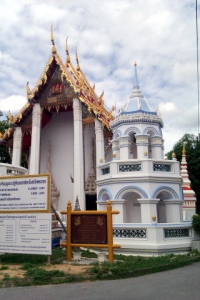 Wat Phra Song is simply a nice temple along the way to Wat Kamphaeng Laeng. It is worth viewing the contemporary stucco work on the mondop’s gable which has been done by one of the masters of the Phetchaburi school, telling the Ramakien, the Thai version of Indian Ramayana. In one scene Todsakan was caught by Phra Rama with assistance of Hanuman, the leader of the monkey army. Wat Phra Song is simply a nice temple along the way to Wat Kamphaeng Laeng. It is worth viewing the contemporary stucco work on the mondop’s gable which has been done by one of the masters of the Phetchaburi school, telling the Ramakien, the Thai version of Indian Ramayana. In one scene Todsakan was caught by Phra Rama with assistance of Hanuman, the leader of the monkey army.Wat Phra Song is situated in the center of Phetchaburi at Matyawong Road. Wat Phra Song is situated in the center of Phetchaburi at Matyawong Road.
Temple >>
Wat Phra Non (Wat Phra Non) (Phetchaburi) 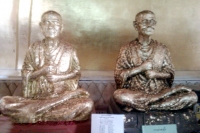 Wat Phra Non (Temple of the Reclining Buddha) is another name for Wat Phra Phuttha Saiyat. It features an impressive 43-meter-long Buddha. It stands at the foot of Khao Wang. Wat Phra Non (Temple of the Reclining Buddha) is another name for Wat Phra Phuttha Saiyat. It features an impressive 43-meter-long Buddha. It stands at the foot of Khao Wang. The temple houses a beautiful reclining Buddha image or Phra Phuttha Saiyat in stucco and brick work, lacquered and covered with gold foil. One of the 4 largest reclining Buddha images in Thailand, it is believed to date back to the middle of the Ayutthaya period. The statue presently enshrined in Phra Wihan (formerly laid outdoors) contains inside many Dvaravati and U-thong Buddha images.
Temple >>
Wat Sa Bua (Wat Sa Bua) (Phetchaburi) 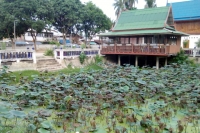 Wat Srabua is one of the oldest temples in Phetchaburi built in the Ayutthaya period. The ancient structure of the temple remains the same as when it was first built. Therefore, if anyone wants to see a specimen of the stucco work at the main Ubosot which was done by artists of the Ayutthaya period, they should come to this temple. Wat Srabua is one of the oldest temples in Phetchaburi built in the Ayutthaya period. The ancient structure of the temple remains the same as when it was first built. Therefore, if anyone wants to see a specimen of the stucco work at the main Ubosot which was done by artists of the Ayutthaya period, they should come to this temple. It is a small symmetrical hall with a curved base. The wall is decorated with pillars. The gable in the east is decorated with stucco in the pattern of Gold Narayana and a giant. The style of the stucco looks like one of the gables in the ordination hall at Wat Yai Suwannaram. The base of the stucco Bai Sema has stones (carved boundary stones) on 4 sides and depicts demons and human beings of 12 nations carrying the Bai Sema. Above the base the second level lines with Garuda and the third level is the ancient Krachang pattern. The fourth level is lotus pattern and on the top stands the big and graceful double Bai Sema. It is located on the eastern slope of Khao Wang hill on Khiri Rathaya Street next to Wat Phranon.
Temple >>
Wat Phlapphla Chai (Wat Phlapphla Chai) (Phetchaburi)  It is one of the old temples worth visiting, not very far from Wat Mahathat. This temple is presumed to have been built in the late Ayutthaya period, A legend is told that in the ancient time, an army camp was once located in the area, therefore a pavilion for the King was built at the edge of the river. Later the temple was built there, and was named after the world Phlapphla, or in English, pavilion of the King. In the center there are superb wood-carved works by artists of the Rattanakosin era. For example, the door panels of ubosot and the main prayer hall and window. It is one of the old temples worth visiting, not very far from Wat Mahathat. This temple is presumed to have been built in the late Ayutthaya period, A legend is told that in the ancient time, an army camp was once located in the area, therefore a pavilion for the King was built at the edge of the river. Later the temple was built there, and was named after the world Phlapphla, or in English, pavilion of the King. In the center there are superb wood-carved works by artists of the Rattanakosin era. For example, the door panels of ubosot and the main prayer hall and window.The door facade of the ordination hall is decorated with stucco done by graceful and distinctive forms of the stucco patterns illustrate different episodes of the Ramayana epic. The panels of the middle window are in the pattern of angels holding double-edged daggers. On the other windows, the carvings are of the lotus patterns. Visitors can also see the Nang Yai Museum shadow plays where nearly 40 pieces are displayed near ubosot. They are all that is left from more than 300 pieces made by Luang Pho Rit, a former abbot, about 100 years ago. The beautiful made puppets are characters in the Ramayana epic. It is located on Damnoen Kasem Road, next to Wat Mahathat and near the Phetchaburi river.
Museum >>
Phra Ram Ratcha Niwet Palace (Phra Ram Ratcha Niwet Palace) (Phetchaburi) 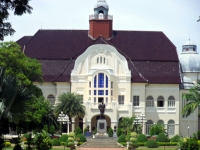 Ban Puen Palace was constructed from 1909 to 1916 by a German architect in European style. It served as a residence for King Rama V during the rainy season. Ban Puen Palace was constructed from 1909 to 1916 by a German architect in European style. It served as a residence for King Rama V during the rainy season. The magnificent Baroque-style Palace of King Chulalongkorn, Rama V, is known as Ban Puen Palace. King Rama V had it constructed for his retreat in rainy seasons. The palace has adopted the modern European architecture designed by the German architect Karl Dohring with his countryman, Dr. Bayer, as the engineer. The palace was named Phra Ram Ratcha Niwet in 1918 to serve as a reception hall for state visitors. Later, King Rama VII turned it into the location of the Boy Scouts Commanding School, Agricultural Teachers Training School, and Sub district Elementary School. Phra Ram Ratcha Niwet is located in the south of Phetchaburi city.
Cave
|
New to t-Globe?
Register for free to get the full power of this web site!
Registered members will be able to: |
|||||||||||||||||||||||||||||||||||||||||||||||||||||||||||||||||||||||||||||||||||
|
|
